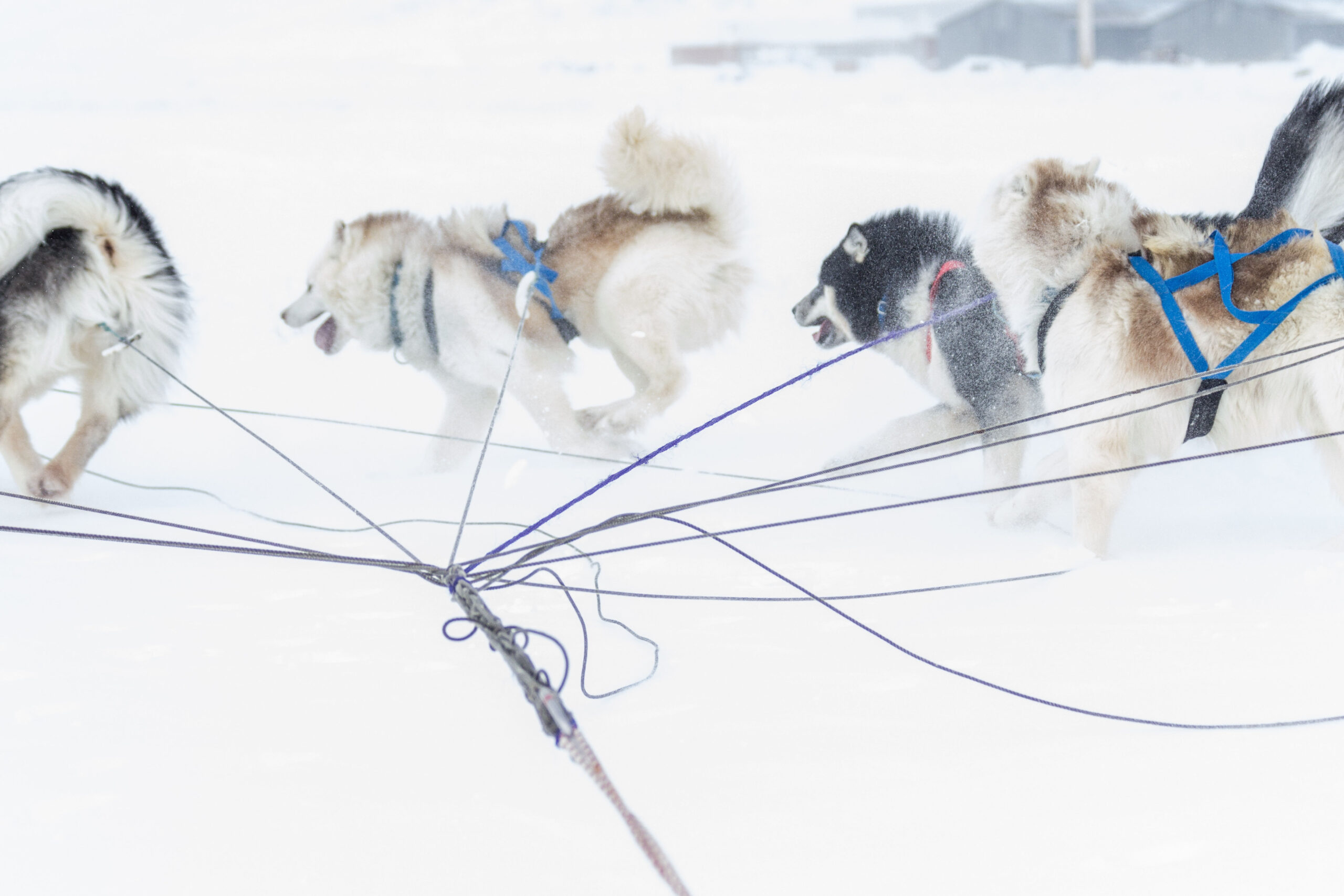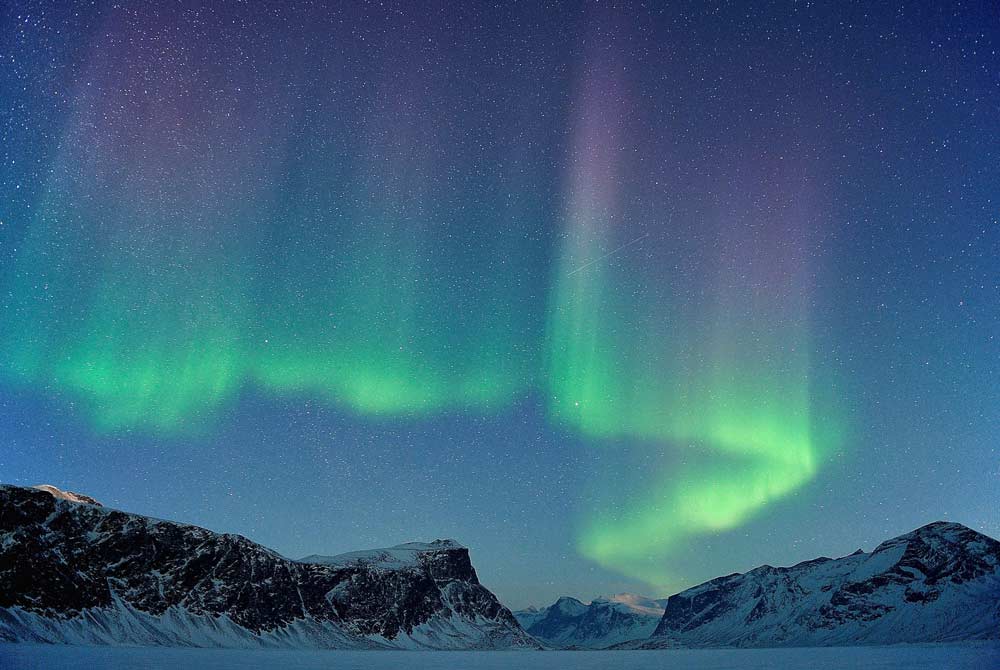The picturesque hamlet of Pond Inlet, also called ‘Mittimatalik’ in Inuktitut after an unknown ancient person presumed to be buried here, is a traditional Inuit community located on the northern tip of Baffin Island near the eastern entrance to the Northwest Passage.
Situated near scenic fiords, glaciers and icebergs, Pond Inlet is famous as a great place to see large pods of narwhal.
Offering a variety of enjoyable outdoor activities to visitors, it is conveniently close to both Tamaarvik Territorial Park and Sirmilik National Park. ‘Mittimatalik’ is also home to the renowned Tununiq Arsarniit Theatre Group.
1,300
95% Inuit
Inuktitut, English
Longitude 77° 59’ W
Latitude 72° 42’ N
Elevation 55m
Pond Inlet is surrounded by mountain ranges, with several dozen glaciers, picturesque fiords and inlets, ice caves, geological hoodoos and drifting icebergs. It is located near the floe edge that occurs in May-June.
Weather & Climate
Summertime temperatures range from 5°C to 15°C. Fall weather is often very windy and it can rain or snow. Fortunately, the hamlet is sheltered by mountains that block the winds and reduce the chill. In the winter months, from mid-November to mid-January, there is no sun, just starlight, moonlight and the Northern Lights, with an average temperature of -40°C.
| Average Temperature in Pond Inlet | |||
|---|---|---|---|
| January | -32oC | February | -34oC |
| March | -30oC | April | -22oC |
| May | -10oC | June | 2oC |
| July | 6oC | August | 4oC |
| September | -1oC | October | -11oC |
| November | -22oC | December | -29oC |
HISTORY
They hunted caribou, seals, fish, polar bears, walrus, narwhals, geese, ptarmigans and arctic hares, moving between winter and summer camps as these animals migrated.
- Dorset Culture (‘Tuniit’ or ‘Sivullirmiut’): 500 BC to 1500 AD
- Thule Culture (Proto-Inuit): 1000 AD to 1600 AD
- Inuit Culture (Eskimo): 1600 AD to present-day
The English moniker ‘Ponds Bay’ was first given to a nearby site about five kilometres (three miles) east of the present-day hamlet in 1818 by the British explorer John Ross, naming it after John Pond the astronomer. The first white settlers then brought the name to the nearby Inuit community that was known to the local people as ‘Mittimatalik’ meaning ‘where is Mittima?’ in Inuktitut. Who Mittima was exactly remains a mystery, but he is believed to be buried here.
European and American whalers hunting bowhead frequented these waters throughout the 19th century. The first whaling station was built here in 1903, but the industry soon collapsed. In 1912, three separate expeditions landed in Pond Inlet in search of gold. Nothing was found, but a small trading post was established. In 1929, Anglican and Catholic missions were erected. A federal government school was built here in the 1960s that included residences for Inuit children whose families still lived out on the land.
Today there are still some intrepid Inuit people living traditionally on the land in special places known as ‘outpost camps.’
ACTIVITIES AND WILDLIFE
It is ringed by scenic mountain ranges, with many glaciers and fiords. There are ice caves to explore, hoodoos to marvel at and abundant species of wild animals to watch, including the magical unicorns of the sea — narwhals. There are also beluga and orca whales, ringed and harp seals, caribou, arctic foxes and wolves, seabirds, geese, gyrfalcons, ptarmigans, gulls and ravens to encounter, plus the occasional polar bear to be viewed from a safe distance.
Visitors often come here to enjoy springtime snowmobile and dog team tours, especially for wildlife viewing along the floe edge and at the bird cliffs on nearby Bylot Island, a sanctuary that is home to a million nesting birds.
Cross-country skiing and igloo camping are other fun activities to do in the spring, when the days are sunny and bright. In the late spring and summer you can also enjoy boat trips for sport fishing and narwhal watching, or go sea kayaking among the icebergs. Nature enthusiasts always enjoy trekking in Sirmilik National Park and camping in nearby Tamaarvik Territorial Park. All of these thrilling activities can be yours to enjoy in Pond Inlet.
ARTS AND CULTURE
Tununiq Arsarniit Theatre Group
For over 20 years now, Pond Inlet has been host to a thriving local community theatre group. Founded in 1987, the Tununiq Arsarniit Theatre Group develops its plays and performances by consensus, involving elders as both actors and writers, always weaving Inuit language and traditional culture into every dramatic issue it tackles for the stage.
This popular theatre troupe has recently developed a new original play titled ‘Qallupilluk’ which features legends, myths and the wisdom of elders.
Parks
Sirmilik National Park
As part of Canada’s national parks system, Sirmilik National Park represents the Northern Eastern Arctic Lowlands Natural Region and portions of the Lancaster Sound Marine Region.
The park comprises three separate land areas: Bylot Island is a spectacular area of rugged mountains, ice fields and glaciers, coastal lowlands and seabird colonies. Oliver Sound is a long, narrow fiord with excellent opportunities for boating, hiking and camping. Borden Peninsula is an extensive plateau dissected by broad river valleys. The park features beautiful landforms and superb wilderness hiking and camping, plus a major seabird colony at Baillarge Bay.
Tamaarvik Territorial Park
This park is located a pleasant half-hour walk from Pond Inlet. With tent platforms, windbreaks, barbecue pits and a comfort station, it provides a nice alternative to hotels. Tamaarvik is popular with visitors and residents alike because of the good berry picking and its close proximity to fishing sites and traditional sod houses.
Bylot Island Migratory Bird Sanctuary
Bylot Island is a Migratory Bird Sanctuary located adjacent to the northern tip of Baffin Island. It is 25 kilometres (16 miles) north of Pond Inlet, across Eclipse Sound.
Covered with mountains, ice fields, steep cliffs, snowfields and glaciers, it provides nesting habitat for large numbers of thick-billed murres and black-legged kittiwakes. The marine waters off the island provide rich foraging for these seabirds. The southwest corner of Bylot Island consists of moist lowland tundra that is ideal nesting habitat for songbirds, shorebirds and waterfowl. Bylot Island has the largest breeding colony of greater snow geese in the Canadian High Arctic. A total of 74 unique species of arctic birds thrive on this island.



